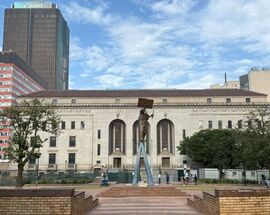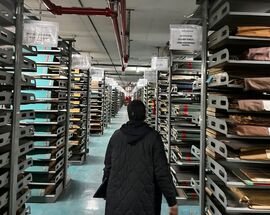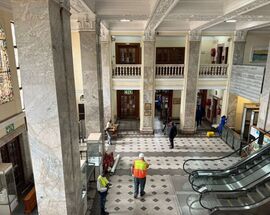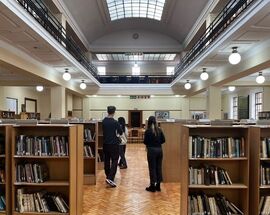The official ceremony, led by Executive Mayor Cllr Dada Morero and city officials, carried all the pomp and ceremony – from a Blue Plaque unveiling to book donations by South African authors. But its most heartfelt moment was the tribute to tireless advocates such as the Johannesburg Heritage Foundation (JHF), Johannesburg Crisis Alliance (JCA), and Griffin Shea of the Johannesburg Literary District whose persistence made this reopening possible. Excited to see the reopened library, our team went to visit.
Johannesburg City Library: From closure to comeback

Johannesburg City Library has come a long way since opening in 1890, just four years after Johannesburg officially became a city. What started as a subscriber-only service in temporary spaces soon evolved into something groundbreaking: in 1923, after a fiery meeting, the library was handed to the town council and became South Africa’s first free-lending library. The library made history again in 1974 by opening its doors to all races, decades before South Africa’s democracy in 1994.
Following a major revamp in 2012, it grew into a modern hub with more than 1.5 million items across diverse collections, a theatre, e-classrooms, and more, its role expanding beyond borrowing books to nurturing curious minds, especially within the surrounding communities.

Photo: Johannesburg Heritage Foundation via Instagram.
The library's role fell away when Johannesburg City Library closed its doors in March 2020, initially due to the pandemic lockdowns. What was meant to be a temporary closure quickly stretched into a marathon pause. By May 2021, it was announced the library would remain closed while over R100 million in repairs and maintenance were carried out – a hefty price for a building that had already undergone a major renovation in 2012.
Refusing to accept its closure and the enormous impact this has on inner city residents, where the library serves as a safe space for young people, a space for study and research, groups like the Johannesburg Heritage Foundation, Johannesburg Crisis Alliance, and Griffin Shea of the Johannesburg Literary District petitioned, protested, and pressed the City of Johannesburg and the Johannesburg Development Agency (JDA) into action. Johannesburg In Your Pocket gave our support to this from the start. For more on the petitions to reopen the Johannesburg City Library, read here.
Persistence paid off. The library’s first floor reopened in March 2025, and by August – on its 90th anniversary and Women’s Day – the building finally reopened. While we celebrate this, there is still work to be done in pressuring authorities to reopen the library on weekends for the thousands of people who live as residents in the city.
"Our first stop was the Harold Strange Africana Collection, one of South Africa’s major collections of Africana, focusing on material from south of the Zambezi River. One of South Africa's major collections... among its treasures is a rare 1688 Xhosa Bible translation."
Visiting the Johannesburg City Library: What to expect

Curious to see the library in all its splendour, we joined Griffin Shea for a long-awaited wander through the Johannesburg City Library on Fri, Aug 15. Shea, an advocate for the library’s reopening, is a trustee of the Johannesburg Literary District – a project dedicated to reviving the library’s neighbourhood through book donations, street libraries, clean-ups, and publishing initiatives – and the owner of Bridge Books, an independent bookstore just a short walk from the library in the Barbican Building. He also pioneers The Underground Booksellers walking tour (which you can book Monday to Saturday), guiding visitors through the inner city’s literary culture and informal book trade. It was only fitting that Shea was our wonderful guide to this historic landmark.
Back in 1935, when the library was opened, Shea says, "The cops sent plainclothed police to monitor the library meetings because people were so impassioned about building the library. And then you had others impassioned about protecting the park. They worried there was going to be this clash over the library – it shows people were passionate about it from the very beginning." A reminder of how much the library has always meant to the city.

The library is located in Beyers Naudé Square, which was previously a public park and is now an open piazza. In the forecourt, facing the Gauteng Legislature (the Johannesburg City Hall), artist Lawrence Lemaoana’s monumental bronze sculpture Democracy is Dialogue depicts a black woman demonstrator carrying a baby on her back. Her message feels especially poignant in light of the library’s long closure and hard-won reopening.
WHAT’S CHANGED AT THE JOHANNESBURG CITY LIBRARY
Critical repairs and upgrades have been made to the library itself: the badly leaking roof has been fixed, a fire protection system has been installed, including the essential water tankers which you'll see outside of the building (there is a project underway for an artist to create an installation around them), and the underground gas suppression system – designed to protect rare and valuable books from fire damage without using water – has been serviced and reactivated.

Photo: Johannesburg In Your Pocket
INSIDE THE LIBRARY
The Johannesburg City Library is a landmark in every sense – from its grand Italianate architecture designed by John Perry, to its marble columns and Venetian teak floors. Step through the heavy bronze doors and beneath the soaring ceiling, and you’re immediately struck by a sense of grandeur. It’s not just the scale of the building that feels impressive – even almost overwhelming – but the immense wealth of knowledge and history it holds.
When you enter the library, you’ll be asked to sign in at the main entrance on the ground floor. The library spans five floors, each with specialist libraries that include:
– Central Reference Library
– Children’s Library
– Michaelis Art Library
– Multimedia Library
– Music Library
– Harold Strange Africana Collection
– Newspaper Reading Room
It's best to request a handy library layout brochure at the Reference section (on the ground floor, to the right as you enter using the main entrance) or ask for directions from the friendly staff to help you find your way around, as signage isn't always clear.
SPACES IN THE JOHANNESBURG CITY LIBRARY
Our first stop was the Harold Strange Africana Collection, one of South Africa’s major collections of Africana, focusing on material from south of the Zambezi River. The collection is named after avid Africana collector Harold Strange, whose 2,300 books were purchased in 1913 as the nucleus of the library. Among its treasures is a rare 1688 Xhosa Bible translation.

We then explored the Visual Arts Room Collection, filled with texts on jewellery design, glassware, and fashion books on the designers like Chanel and Yves Saint Laurent. The Newsroom collection was a standout, with its archive housing South African newspapers dating back 200 years ago; we were thrilled to stumble across copies of The Star newspaper from 1894.
Another highlight was the Library Theatre, tucked away on the lower level. As Shea led us down, we weren’t quite sure where we were going. The floor was quiet, with hardly anyone around. Then he opened the doors to reveal a special space: a large stage with full audio production facilities – impressive, yet severely underutilised. It's a space begging to be used for workshops, productions, and book launches.
“That’s the main reading collection, so where you would go to find books for pleasure reading, if you want a John Grisham for the weekend,” Shea shared about the The Young Adult Lending Collection. It's also a space ideal for studying, assignments, or to do some remote work (although the WiFi was down during our visit), and a quick peek into the children’s section, which brings a real sense of warmth to the building.

A WORK IN PROGRESS
Not all areas were open during our visit – the Music Library, for instance – and with limited operating hours (it’s still closed on weekends) can make access tricky. There were also some rooms still having books organised or the floors were waiting on their final varnish. Saturday openings of the library are being discussed at the Local Labour Forum, though any changes may require further negotiations at the Bargaining Council due to financial implications.
Johannesburg City Library: FAQs
How do I register to access the library?To register as a library member (for physical and digital borrowing), visit your nearest library with proof of residence and an ID, then complete a membership form. For digital membership, visit www.cojelearning.org.za or fill out the online form link, follow the link under the "become a member" section and complete the online membership form. You can later upgrade your digital membership to full membership by taking your acceptance email to your nearest library branch.
Can I use my existing Joburg library card at the City Library?
Yes. The membership card you receive works across all Joburg libraries.
Where can visitors park?
The library does not provide visitor parking.
Is there a drop-off/pick-up point for e-hailing?
There’s no dedicated point, but passengers can be dropped off anywhere around the library.








Comments